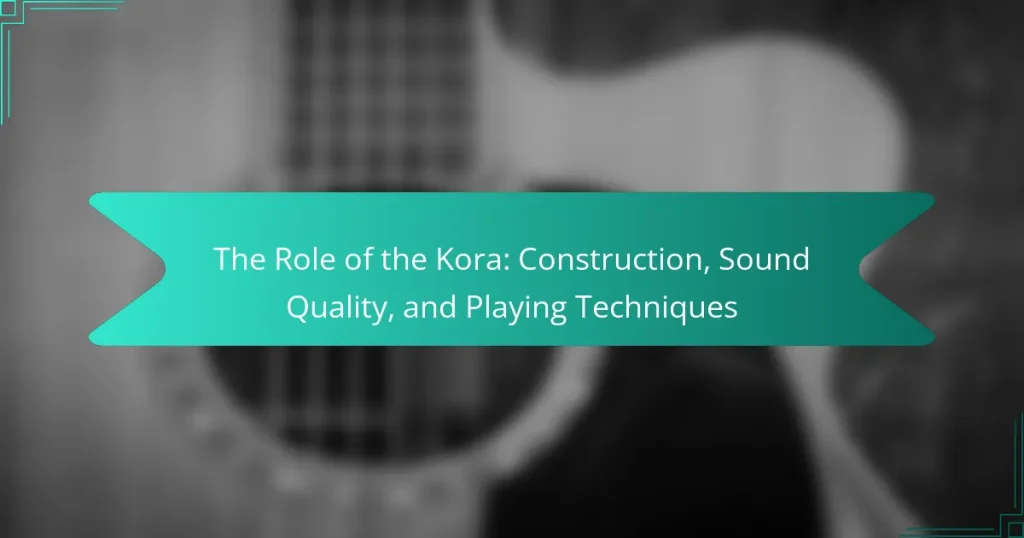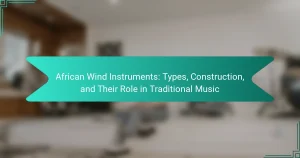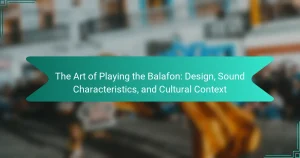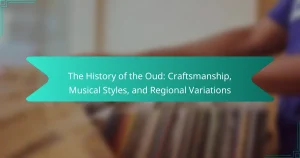The Kora is a traditional West African stringed instrument known for its large calabash body and long neck with 21 strings. This article explores the construction, sound quality, and playing techniques of the Kora, highlighting its significance in music and cultural heritage. The Kora is often played by Griots, who use it to accompany storytelling and convey historical and social messages through intricate melodies and rhythms. Additionally, the article discusses the Kora’s vital role in ceremonies and celebrations across West Africa, emphasizing its importance in preserving oral history.

What is the Kora and its significance in music?
The Kora is a traditional West African stringed instrument. It features a large calabash body and a long neck with 21 strings. The Kora is significant in music for its unique sound and cultural heritage. It is often used in storytelling and oral history. The instrument is played by skilled musicians known as Griots. Griots use the Kora to accompany songs that convey history and social messages. The Kora’s music is characterized by intricate melodies and rhythms. It plays a vital role in ceremonies and celebrations across West Africa.
How is the Kora traditionally constructed?
The Kora is traditionally constructed using a combination of wood, animal skin, and metal strings. The body of the Kora is made from a large gourd, which serves as a resonator. A wooden neck is attached to the gourd, typically carved from hardwood. The bridge, which supports the strings, is also crafted from wood. Animal skin, often from goats, is stretched over the gourd to create the soundboard. The Kora usually has 21 strings made from nylon or metal, which are attached to tuning pegs on the neck. This construction allows for a rich and resonant sound, crucial for its role in traditional West African music. The craftsmanship of the Kora has been passed down through generations, ensuring its cultural significance and acoustic quality.
What materials are used in the construction of the Kora?
The Kora is constructed using several key materials. The body of the Kora is traditionally made from a large gourd, which acts as a resonator. The neck is typically crafted from hardwood, providing durability and strength. The strings are usually made from nylon or animal gut, influencing the instrument’s sound quality. In some cases, metal strings are also used for a brighter tone. The bridge, where the strings rest, is often made from wood as well. These materials contribute to the Kora’s unique sound and playability. The combination of these elements has been refined over centuries, ensuring the Kora’s prominence in West African music.
How does the construction affect the Kora’s sound quality?
The construction of the Kora significantly affects its sound quality. The materials used in the Kora’s body influence its resonance and tonal clarity. A traditional Kora features a wooden neck and a gourd resonator, which contribute to its rich, warm sound. The size and shape of the gourd also impact the volume and projection of the sound. Additionally, the strings, typically made from nylon or animal gut, affect the instrument’s timbre and sustain. The tension of the strings can modify the pitch and overall sound quality. Research indicates that variations in construction techniques can lead to distinct sound profiles among different Koras. This variation highlights the importance of craftsmanship in achieving desired sound characteristics.
What are the unique sound qualities of the Kora?
The Kora produces a unique sound characterized by its bright, resonant tones. This instrument has a wide range, allowing it to play both melody and harmony simultaneously. The Kora’s sound is often described as ethereal and soothing, making it suitable for storytelling and ceremonial music. Its construction, featuring a large gourd resonator and strings made from nylon or gut, contributes to its distinct timbre. The Kora’s playing technique involves plucking the strings with the fingers, creating a percussive yet melodic sound. This combination of attributes results in a rich and complex auditory experience. The Kora is integral to West African music traditions, further enhancing its cultural significance and unique sound qualities.
How does the Kora’s design influence its tonal range?
The Kora’s design significantly influences its tonal range through its unique construction features. The Kora has a large resonator made from a gourd, which enhances the volume and richness of its sound. Its long neck allows for a wider range of notes, facilitating complex melodies. The strings, typically made from fishing line or nylon, contribute to the instrument’s bright and clear tones. The number of strings, usually 21, provides a diverse harmonic palette. The bridge design affects string vibration, impacting overall sound quality. Additionally, the playing technique, including fingerpicking, further shapes the tonal expression. These design elements collectively enable the Kora to produce a distinctive and versatile sound.
What role do the strings play in the Kora’s sound production?
The strings of the Kora are essential for sound production. They are typically made from nylon or animal gut. When plucked, the strings vibrate, creating sound waves. The tension and thickness of each string affect pitch. The Kora usually has 21 strings, contributing to its unique tonal range. The strings are attached to a resonating body, which amplifies the sound. This design allows for a rich blend of melodies and harmonies. The quality of the strings directly influences the instrument’s overall sound quality.
What techniques are used to play the Kora?
The Kora is played using various techniques that enhance its unique sound. One primary technique is plucking the strings with the fingers. This method allows for a range of dynamics and tonal variations. Another technique involves using a thumb and index finger to create different articulations. Players often use a technique called “tremolo,” which involves rapid alternation between two notes. Additionally, sliding between notes adds expressiveness to the performance. Some players incorporate rhythmic patterns to create complex musical phrases. Mastery of these techniques requires practice and a deep understanding of the instrument. These methods contribute to the Kora’s distinctive sound and cultural significance.
How do playing techniques vary among different musicians?
Playing techniques vary among different musicians based on their cultural background, training, and personal style. Musicians from West Africa may emphasize traditional fingerpicking techniques on the kora. In contrast, contemporary musicians might incorporate modern techniques like strumming or using a plectrum. Additionally, the emotional expression and improvisation styles differ significantly among musicians. For example, some musicians focus on rhythmic patterns, while others prioritize melodic embellishments. This diversity in playing techniques enhances the overall sound and versatility of the kora.
What are common challenges faced by beginners learning to play the Kora?
Beginners learning to play the Kora face several common challenges. One significant challenge is mastering finger coordination. The Kora requires intricate finger movements that can be difficult to develop initially. Another challenge is understanding the tuning system. The Kora has a unique tuning that differs from standard Western instruments. Additionally, beginners often struggle with rhythm and timing. The Kora’s music involves complex rhythms that can be hard to grasp.
Another common issue is the physical demands of playing. Holding the Kora and maintaining posture can be uncomfortable for newcomers. Lastly, finding quality instruction can be a challenge. Access to experienced teachers may be limited, making it harder to learn effectively. These factors contribute to the overall difficulty beginners experience when learning to play the Kora.
How does the Kora connect to cultural traditions?
The Kora is a traditional West African musical instrument that connects deeply with cultural traditions. It serves as a symbol of heritage and is often played during important ceremonies. The Kora is typically associated with the Griot class, who are oral historians and musicians. These Griots use the Kora to tell stories, preserve history, and pass down knowledge through generations. The instrument’s construction reflects local craftsmanship, using materials like calabash and animal skin. Its music is integral to cultural celebrations, weddings, and funerals, reinforcing community bonds. The Kora’s melodies often incorporate traditional rhythms and scales unique to various ethnic groups. This connection to cultural traditions emphasizes the Kora’s role in maintaining and expressing identity within West African societies.
What are the contemporary uses of the Kora in modern music?
The Kora is used in contemporary music for fusion genres and traditional performances. Musicians blend Kora with jazz, pop, and world music. This creates unique soundscapes that attract diverse audiences. Artists like Toumani Diabaté and Ballaké Sissoko showcase the Kora in modern compositions. The instrument’s rich tonal quality enhances collaborative projects. It is also featured in film scores and global music festivals. The Kora’s versatility allows for both solo performances and ensemble settings. Its integration into modern music continues to evolve, reflecting cultural exchanges.
What tips can help improve Kora playing skills?
To improve Kora playing skills, practice regularly to build muscle memory and technique. Focus on finger placement for better control and sound quality. Listening to experienced players can provide insights into style and technique. Use a metronome to develop timing and rhythm. Experiment with different strumming patterns to enhance versatility. Record your practice sessions to identify areas for improvement. Engaging with a teacher can provide personalized feedback and guidance. Regularly maintaining the instrument ensures optimal sound and playability.
The Kora is a traditional West African stringed instrument known for its unique sound and cultural significance. This article explores the Kora’s construction, detailing its materials, design, and how these elements influence its sound quality and tonal range. It also examines various playing techniques, the challenges faced by beginners, and the Kora’s connection to cultural traditions and contemporary music. Additionally, tips for improving Kora playing skills are provided, highlighting the instrument’s versatility and importance in both traditional and modern contexts.




